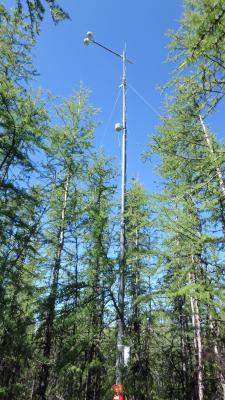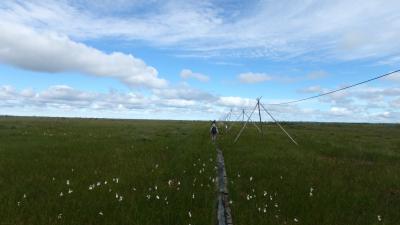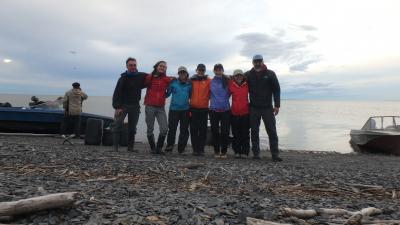Bringing the Field to the STEM Classroom
Teaching science gives me the satisfaction of sharing my passion for the natural world with others. I try to create opportunities for students to experience science outside of the classroom much like I did in college, through local field trips, or even identifying and mapping out the various large landscape rocks scattered around our school grounds. I have even taken advantage of school-wide cultural outings to give impromptu lessons, such as the annual eighth-grade trip to Washington, D.C. The bus ride follows the Susquehanna River and the monuments in our nation’s capital feature an array of stones that are good for rock and mineral identifications. But I lacked an extended field experience and therefore knew that I wasn’t able to make science come alive fully for my students. PolarTREC has given me the opportunity to change that.
Benefits of Participating in Science Expeditions
Studying the science taught in the classroom in the field under natural conditions is a great way to strengthen one’s content knowledge and get firsthand experience. The teacher has a chance to work with researchers on their current science projects, collecting data to help answer questions about the physical state of our planet. Being right in the mix of it, working with a research team, gives the teacher an advantage when it comes time to explain to students how the tough questions of science are answered. 
To bring my passion into the classroom, I share my past experiences, whether it’s with photos or through discussion. I believe that having my students know that I am not only able to teach their subject, but I am also actively growing my content knowledge is a powerful tool. While on hiking, camping, or fishing trips I always have my science class in mind as I snap pictures of the world’s ever-changing landscape. Sometimes it is just to enforce the lesson with a visual reference related to the topic and how it looks in its natural environment. For example, while hiking in the Adirondack mountains I took various pictures of rockslides and talus deposits forming at the base of cliffs, showing actual examples to use when teaching the topic of mass movement. This gives the students an idea of what science looks like outside of the classroom and, in turn, will encourage the students to think differently about their daily lives and surroundings. PolarTREC takes this to another level as students can follow a Polar expedition via blog posts and live webinar sessions from remote areas of study.
Expectations of the Experience
As I was embarking on the expedition to the far Northeastern regions of Siberia to assist in collecting data in the study of permafrost vulnerability in the Arctic, I tried to keep my expectations open. What I did hope to learn was how scientists develop a team and their strategy to achieve results. Working side by side with Mike Loranty, PhD., from Colgate University, on this project allowed me to not only learn about the process, but to be part of the process. 
On a daily basis we would meet as a group to plan out the following day’s activities, and since we had a large team to work with there were many days that we split up to maximize our time in the field. We had to keep in mind the size of our group and the number of user days we had in the field. Mike and the team would decide how to split up the members based on the group’s strength and experience. After the groups were set we would go over the protocol for data collection, map out the field sites to survey, and round up all the necessary tools and equipment for the day’s work. Some days were spent in the lab and some in the field, but either way if there was any new equipment involved, an experienced member of the team would demonstrate how to use it, or the lead researcher himself would give a detailed lesson. Upon completion of the day’s activities we would resume with an update about what was accomplished and how it went.
This experience gives me an excellent insight into how science is performed in the field and will allow me to make parallels to carrying out small-scale experiments at the middle school level. In the middle school we begin a question to answer, although a lot of times it is a prompted, we collect data in a controlled environment, and make conclusions based on that data. After my time in the Arctic, I intend to have the students formulate some of their own questions, develop a plan to answer those questions, execute their plans in a timely manner and come up with a conclusion based on their own results.
It’s through field work and studying science in its most natural form that I have found the most enjoyment. From that I have the strong desire to help my students find that same level of enthusiasm for science. 
Establishing a program for science outside the classroom will build similar opportunities for students to experience what it’s like to work in the field. For example, a local trip to the Niagara Gorge would get students outside and hiking around looking at a million of years of history locked up in the stratigraphy and identifying fossil features found in the rocks. On a grand scale, I would like to see a program take students on an extended overnight stay in the Adirondack mountains or Alleghany State Park where they can feel the true experience of being outdoors, camping and collecting field data, studying science in its most natural form. This is something that keeps me interested in continuing to teach science and I think my experience with the PolarTREC program will help me get there.
A Diverse Research Team
During my time in Siberia I had the notion that I would be working multiple people at varying levels of expertise and education. Our part of research team alone brought my collaborating researcher, Mike Loranty, his postdoctoral candidate, and one undergraduate student from Colgate University. The remainder of the team included four other researchers involved in the project from the Woods Hole Research Center, University of Alaska at Fairbanks, Alabama State, and St. Olaf College. Additionally, the team included PhD. candidates from Notre Dame and University of Washington, along with three graduate students and me, the science teacher from Cheektowaga, New York.
This diverse group of scientists allowed me, as a teacher, to see how this experience impacts the team at each level, understanding of what it means to each person in the team as we worked together side by side on a daily basis. Working with the graduate and undergraduate students was especially interesting to me as my students are approaching the point of making college decisions. As part of the PolarTREC program, Mike Loranty and a couple of his students came to my school prior to leaving on our expedition to develop some interest in what we will be studying and what it means to do field work. Post expedition, Mike Loranty and his crew from Colgate University plan on making another appearance as it will be a new school year and we will have new batch of students to inspire with further discussions about what it is like to be a science major, what it’s like to work in the field, and what kind of opportunities are available to college students studying science. Hearing this information from the researcher, and even more importantly from the undergraduates, is a powerful message to the students, as they will be faced with career decisions in the near future.
Teaching Concepts of Polar Science
The concept of climate change and global warming is a hot topic in science these days because our planet is going through some radical changes that will affect the future of Earth. Studying science in the Polar regions of our planet may be the key to some of the answers as the effects of global climate change are happening at a faster rate in these regions. Understanding how these accelerated changes in the Arctic affect us in the lower 48 states and what a warmer climate might look like for us is a topic that my students can benefit from. It’s a topic that relates directly to them and the things they do in their daily routines. 
We already touch on the topics of global warming, greenhouse gases and energy resources, but in the upcoming year we will dig deeper into alternate energy resources, closely monitor changes in the Arctic, how it is affecting us today, and analyze the details of the energy budget. It all comes down to the amount of energy entering an area versus the amount that is exiting. This was a large focus of the work we did in Siberia; we used technology to measure the amount of short wave radiation entering in the form of electromagnetic rays from the sun. These rays are absorbed and re-released back into the atmosphere in the form of long wave radiation. Basically, if more energy is coming in than out, then the area is warming up and thawing the permafrost layers beneath the thin soil layer. Understanding what conditions and factors affect the energy levels in a system can give scientists a better idea about permafrost vulnerability rates. As my students and I dig more deeply into this topic, we will discover how changes in the Arctic have an impact on our everyday lives.
Future Endeavors
As a new school year approaches I am eager to share the experiences of the program with my peers in our department meetings and with a focus group of like-minded Earth Science teachers in the New York State region. 
In short, the PolarTREC program has allowed me to take my experiences, share them with my students, and inspire young researchers to think differently about their daily lives and surroundings. I will continue to pursue field opportunities for myself and my students because it’s my passion and that’s how science comes alive.

| Attachment | Size |
|---|---|
| Download Report (1.06 MB)1.06 MB | 1.06 MB |
This program is supported by the National Science Foundation. Any opinions, findings, and conclusions or recommendations expressed by this program are those of the PIs and coordinating team, and do not necessarily reflect the views of the National Science Foundation.
